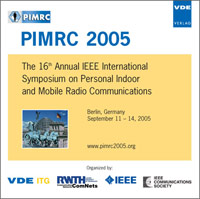Dynamic Allocation of OVSF Codes to Access Terminals with an Adaptive Antenna Array
Conference: PIMRC 2005 - 16th Annual IEEE International Symposium on Personal Indoor and Mobile Radio Communications
09/11/2005 - 09/14/2005 at Berlin, Germany
Proceedings: PIMRC 2005
Pages: 5Language: englishTyp: PDF
Personal VDE Members are entitled to a 10% discount on this title
Authors:
Kavak, Adnan; Demiray, H. Engin (Dept. of Computer Eng., Kocaeli University, Izmit, 41040 Turkey)
Karakoc, Mustafa (Dept. of Electronics and Comp. Ed., Kocaeli University, Izmit, 41380, Turkey)
Cleveland, Joseph R. (Wireless Systems Lab., Samsung Telecommunications America, Richardson, TX, USA)
Abstract:
Orthogonal variable spreading factor (OVSF) codes are widely used to provide variable data rates for supporting different bandwidth requirements in wideband code division multiple access (WCDMA) systems. Many works in the literature have intensively investigated code placement and replacement schemes in OVSF code trees to reduce the code blocking probability and increase the code spectral efficiency. This paper describes a method for dynamic allocation of OVSF codes when a base station transceiver (BTS) is equipped with an adaptive antenna array (AAA) utilizing spatial diversity of mobile users to support more users in WCDMA cellular network. In our method, the new user is assigned an OVSF code of an active user whose downlink beam has the smallest spatial correlation with the channel vector of the new user. The performance of the dynamic OVSF code assignment with the AAA (SA-DCA) is justified through computer simulations under varying traffic load conditions. The results show that the SA-DCA method significantly reduces call blocking probability and improves spectral efficiency in the system when compared to the conventional (CCA) and dynamic (DCA) OVSF code assignment schemes without AAA.


